 |
 |
 |
| |
Pooled Week 96 efficacy, resistance and safety results from the double-blind, randomised, Phase III trials comparing rilpivirine (RPV, TMC278) versus efavirenz (EFV) in treatment-naïve, HIV-1-infected adults
|
| |
| |
Reported by Jules Levin
Presented at the 6th International AIDS Society Conference on HIV Pathogenesis, Treatment and Prevention, Rome, Italy, 17-20 July 2011
CJ Cohen,1 JM Molina,2 I Cassetti,3 P Chetchotisakd,4 A Lazzarin,5 F Rhame,6 HJ Stellbrink,7 L Taisheng,8 H Crauwels,9 L Rimsky,9 S Vanveggel,9 P Williams,9 K Boven10
1Community Research Initiative of New England, Boston, MA, USA; 2Department of Infectious Diseases, Paris, France; 3Helios Salud, Buenos Aires, Argentina; 4Faculty of Medicine, Khon Kaen, Thailand; 5Vita-Salute, San Raffaele University, Milan, Italy; 6Abbott Northwestern Hospital, Minneapolis, MN, USA; 7ICH Study Center, Hamburg, Germany; 8Department of Infectious Diseases, PUMCH, Beijing, China; 9Tibotec BVBA, Beerse, Belgium; 10Tibotec, Titusville, NJ, USA

INTRODUCTION
· ECHO (TMC278-C209, NCT00540449)1 and THRIVE (TMC278-C215, NCT00543725)2 were global, randomised, double-blind, double-dummy, Phase III trials in treatment-naïve, HIV-1-infected adults (Figure 1)
- In the Week 48 primary analysis, RPV 25 mg qd showed noninferior efficacy to EFV 600 mg qd (primary objective), in each trial
- RPV had significantly lower rates of grade 2-4 adverse events (AEs) at least possibly related to treatment, rash, dizziness, abnormal dreams/nightmares, and significantly lower lipid elevations than EFV.1,2
· In a preplanned pooled Week 48 primary analysis of these two trials
- 84% of patients in the RPV group and 82% of patients in the EFV group achieved viral load <50 copies/mL (difference in response: 2.0% [95% confidence interval (CI): -2.0%, 6.0%]; intent-to-treat, time-to-loss-of-virologic-response [ITT-TLOVR] algorithm)
- Responses in the baseline viral load ≤100K copies/mL subgroup were 90% (RPV; N'=368) and 84% (EFV; N'=330) (difference: 6.6% [1.6%, 11.5%]) and in the baseline viral load >100K copies/mL subgroup were 77% (RPV; N'=318) vs 81% (N'=352; EFV) (difference: -3.6% [-9.8%, 2.5%].3
· RPV is approved in the USA as a single-agent tablet4 and is being developed as a fixed-dose single-tablet regimen with tenofovir (TDF)/emtricitabine (FTC).5
· Here we present the pooled 96-week efficacy, safety and virology results.

· Main inclusion criteria were viral load ≥5,000 copies/mL, no NNRTI resistance-associated mutations (RAMs) (from 39 NNRTI RAMs based on a list of 446) and sensitivity to the N(t)RTIs (determined using Virco®TYPE).
· Stratification factors were screening viral load (ECHO and THRIVE) and N(t)RTI background (THRIVE only).
· Patients were recommended to take RPV/RPV placebo with food and EFV/EFV placebo on an empty stomach, at bedtime.
· The primary objective was to demonstrate noninferiority (12% margin) versus EFV in confirmed response (viral load <50 copies/mL, ITT-TLOVR algorithm) at Week 48.
· Secondary objectives included efficacy and safety/tolerability over 96 weeks.
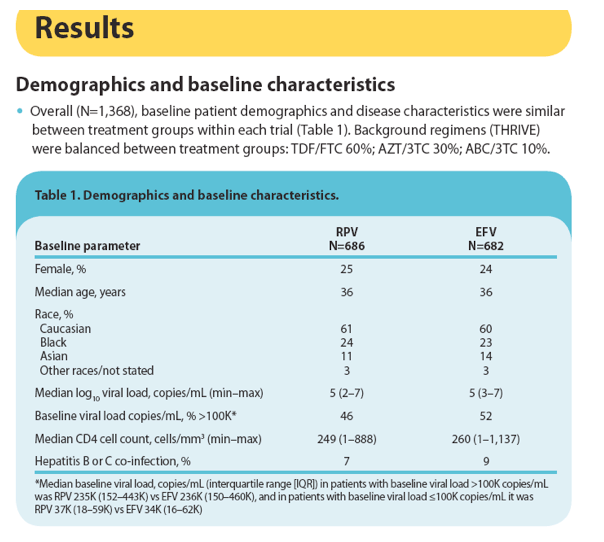
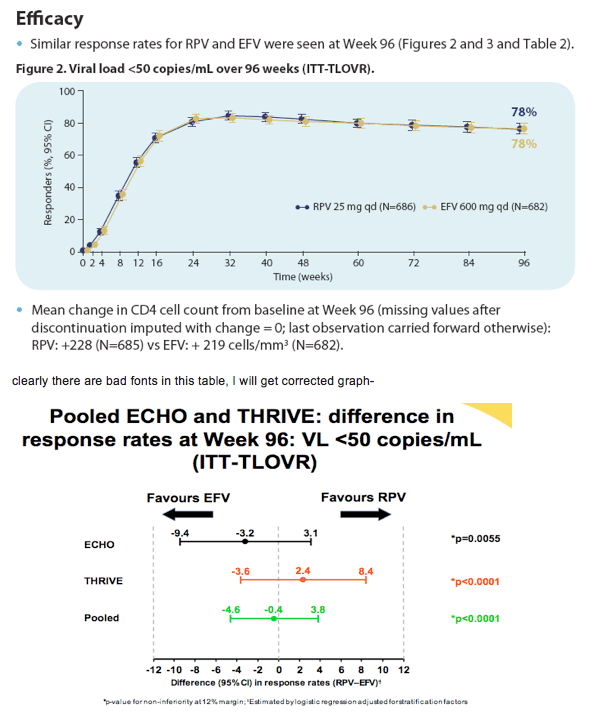
clearly there are bad fonts in this table, I will get corrected graph-
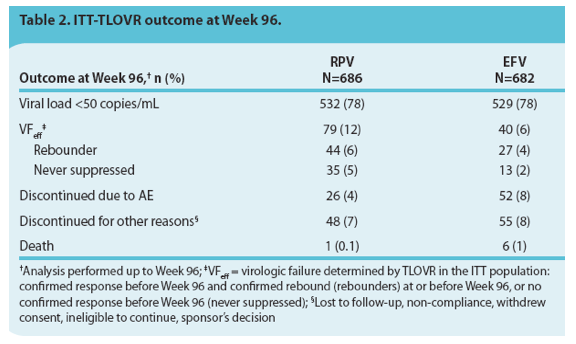
· Similar response rates for RPV and EFV were seen at Week 96, based on the ITT snapshot analysis (last viral load value in the Week 96 window [90-103 weeks] <50 copies/mL; missing = failure): RPV 76% vs EFV 77%; difference between groups -0.15% (95% CI: -4.7%, 4.3%) and in the per protocol TLOVR analysis: RPV 79% vs EFV 78%; difference 0.4% (-4.0%, 4.9%).
· The majority of patients reported >95% adherence. Response rates were high and similar between treatment groups in patients with >95% reported adherence or baseline viral load ≤100K (Figure 4). Suboptimal adherence (≤95%) and baseline viral load >100K were associated with lower responses in both groups.
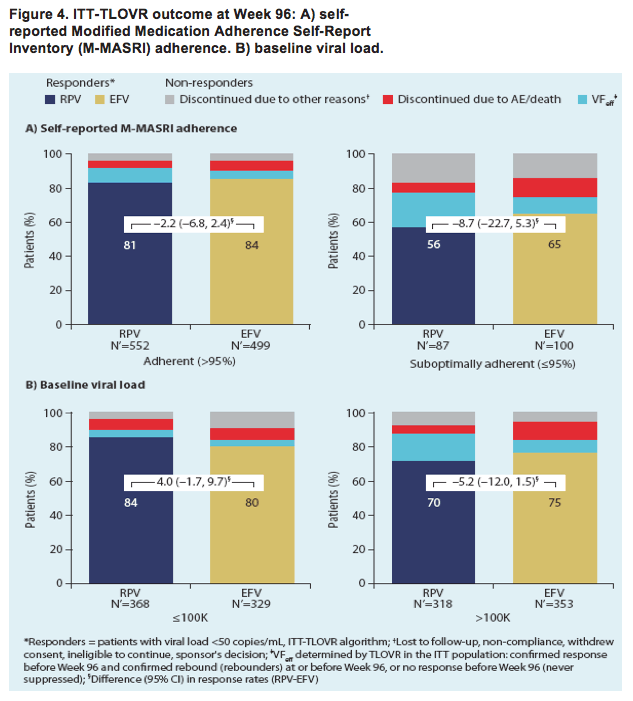
· Overall responses declined with lower CD4 cell counts in both treatment groups. Responses were (≥200 cells/mm3): RPV 82% vs EFV 79%, (≥50-<200 cells/mm3): RPV 71% vs EFV 75% and (<50 cells/mm3): RPV 56% vs EFV 69%.
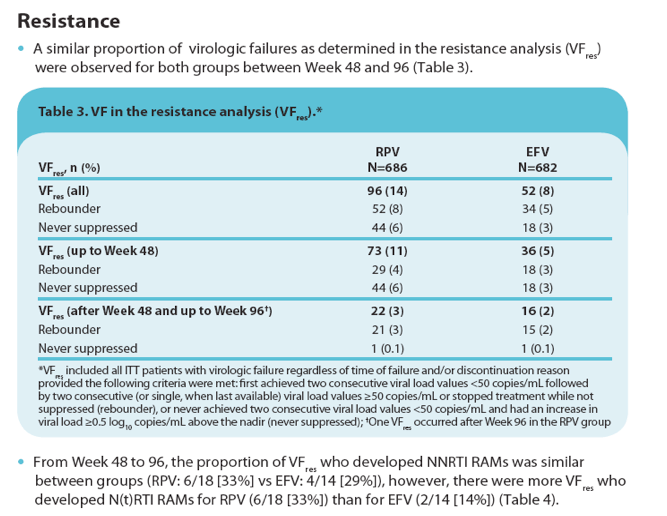
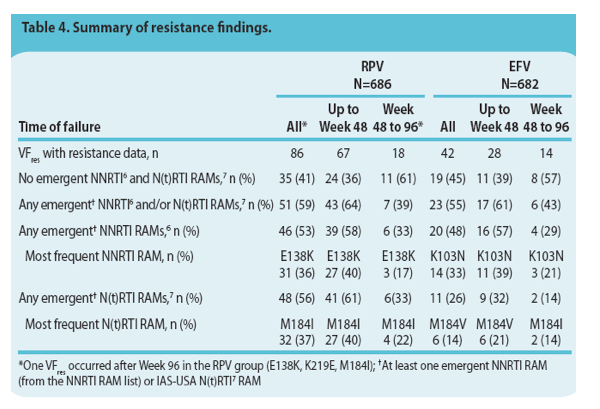
Safety
· RPV showed lower incidences than EFV of grade 2-4 overall AEs at least possibly related to treatment, AEs leading to discontinuation, rash, dizziness, abnormal dreams/nightmares (Table 5) and grade 2-4 lipid abnormalities (Table 6).
· The 96-week analysis revealed that there were no new safety concerns beyond Week 48 in both treatment groups, and only 2% of RPV and 4% of EFV patients reported at least possibly treatment-related grade 2-4 AEs during the second year of treatment (Table 5).

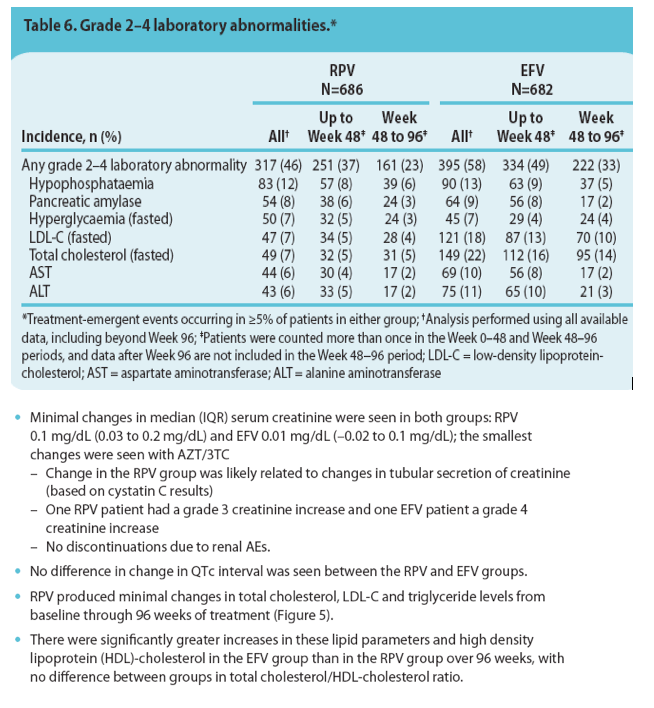

References
1. Molina JM, et al. Lancet 2011;378:238-46.
2. Cohen CJ, et al. Lancet 2011;378:229-37.
3. Cohen CJ, et al. XVIIIth International AIDS Conference (IAC), Vienna, Austria, 18-23 July 2010. Abstract THLBB206.
4. FDA label for EDURANT™ (rilpivirine) tablets. 2011.
5. Mathias A, et al. XVIIIth IAC 2010. Abstract LBPE17.
6. Tambuyzer L, et al. Antivir Ther 2009;14:103-9.
7. Johnson VA, et al. Top HIV Med 2009;17:138-45.
|
| |
|
 |
 |
|
|